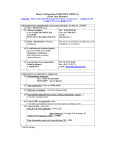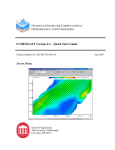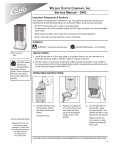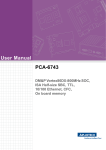Download Cisco - Cisco Secure VPN Client: Troubleshooting with View Log
Transcript
Cisco − Cisco Secure VPN Client: Troubleshooting with View Log Table of Contents Cisco Secure VPN Client: Troubleshooting with View Log............................................................................1 Document ID: 14127................................................................................................................................1 Introduction..........................................................................................................................................................1 Before You Begin................................................................................................................................................1 Conventions............................................................................................................................................1 Prerequisites............................................................................................................................................1 Components Used...................................................................................................................................1 View Log Message Format..................................................................................................................................2 Troubleshooting with the View Log....................................................................................................................2 Successful IKE Establishment................................................................................................................2 Failed IKE Establishment.......................................................................................................................3 IKE Message Table.................................................................................................................................4 How IKE Works................................................................................................................................................10 IKE Example.........................................................................................................................................10 Related Information...........................................................................................................................................11 i Cisco Secure VPN Client: Troubleshooting with View Log Document ID: 14127 Introduction Before You Begin Conventions Prerequisites Components Used View Log Message Format Troubleshooting with the View Log Successful IKE Establishment Failed IKE Establishment IKE Message Table How IKE Works IKE Example Related Information Introduction This document describes Cisco Secure VPN Client View Log messages and explains how to use the View Log messages to troubleshoot problems with establishing IPSec communications. The user must enable the View Log before logging occurs. Log files can be saved to a disk for future analysis. Before You Begin Conventions For more information on document conventions, see the Cisco Technical Tips Conventions. Prerequisites There are no specific prerequisites for this document. Components Used The information in this document is based on the software and hardware versions below. • Cisco Secure VPN Client 1.1. The information presented in this document was created from devices in a specific lab environment. All of the devices used in this document started with a cleared (default) configuration. If you are working in a live network, ensure that you understand the potential impact of any command before using it. Cisco − Cisco Secure VPN Client: Troubleshooting with View Log View Log Message Format Two types of messages can appear in the View Log: error messages and Internet Key Exchange (IKE) messages. Error messages are defined in the Cisco Secure VPN Client View Log error message table. The format of the IKE message is as follows: TIME Connection Name Transmit direction IKE Message The following example is a typical message from the View Log: 01:38:02.570 Balt Corporate Access − SENDING>>>> ISAKMP OAK MM (SA) View Log Field Time Field Definition Time the message is written to the log. Connection Policy Editor Name Connection name associated with the IKE activity. Transmit Direction IKE Message Direction of the IKE message (Sending or Receiving). IKE message indicating type of Internet Security Association and Key Management Protocol (ISAKMP) message being processed. IKE messages are defined in the Cisco Secure VPN Client View Log IKE message table. Example 01:38:02.570 Balt Corporate Access SENDING>>>> ISAKMP OAK MM (SA) Troubleshooting with the View Log The following table lists different scenarios and the accompanying debug messages. You can refer to this information when interpreting the View Log file. Use this table in conjunction with the Cisco Secure VPN Client View Log IKE Message table. Successful IKE Establishment If the IKE establishment is successful, a key is displayed in the Cisco Secure VPN Client icon (located on the Taskbar at the bottom of your screen). Cisco − Cisco Secure VPN Client: Troubleshooting with View Log Description Problem Symptoms Successful Successful Security main mode Association negotiation (SA) (pre−share) established. Key is displayed in Cisco Secure VPN Client icon. Successful aggressive mode negotiation (pre−share) Successful SA established. Key is displayed in Cisco Secure VPN Client icon. Debug Messages Pre−share − Initiating IKE Phase 1 (IP ADDR=IPSec peer) Pre−share − SENDING>>>> ISAKMP OAK MM (SA) Pre−share − RECEIVED<<< ISAKMP OAK MM (SA) Pre−share − SENDING>>>> ISAKMP OAK MM (KE, NON, VID, VID) Pre−share − RECEIVED<<< ISAKMP OAK MM (KE, NON) Pre−share − SENDING>>>> ISAKMP OAK MM *(ID, HASH, NOTIFY:STATUS_INITIAL_CONTACT) Pre−share − RECEIVED<<< ISAKMP OAK MM *(ID, HASH) Pre−share − Established IKE SA MY COOKIE 1f f5 e4 d 84 30 f9 5c HIS COOKIE 4c af 1f 2c 20 16 d0 ec Pre−share − Initiating IKE Phase 2 with Client IDs (message id: 61965C8D) Initiator = IP ADDR= your_address, prot = 0 port = 0 Responder = IP ADDR= IPSec peer, prot = 0 port = 0 Pre−share − SENDING>>>> ISAKMP OAK QM *(HASH, SA, NON, ID, ID) Pre−share − RECEIVED<<< ISAKMP OAK QM *(HASH, SA, NOTIFY:STATUS_RESP_LIFETIME, NON, ID, ID) Pre−share − SENDING>>>> ISAKMP OAK QM *(HASH) Pre−share − RECEIVED<<< ISAKMP OAK QM *(HASH, NOTIFY:NOTIFY_CONNECTED) Pre−share − Loading IPSec SA (Message ID = 61965C8D OUTBOUND SPI = 405 INBOUND SPI = 493B30CC) Pre−share − Initiating IKE Phase 1 (IP ADDR= IPSec peer) Pre−share − SENDING>>>> ISAKMP OAK AG (SA, KE, NON, ID, VID, VID) Pre−share − RECEIVED<<< ISAKMP OAK AG (SA, KE, NON, ID, HASH) Pre−share − SENDING>>>> ISAKMP OAK AG *(HASH) Pre−share − Established IKE SA MY COOKIE 73 9c 76 19 4f 5e 35 c8 HIS COOKIE e9 94 9c 82 64 b2 fa 44 Pre−share − Initiating IKE Phase 2 with Client IDs (message id: 99F08C75) Initiator = IP ADDR= your_address, prot = 0 port = 0 Responder = IP ADDR= IPSec peer, prot = 0 port = 0 Pre−share − SENDING>>>> ISAKMP OAK QM *(HASH, SA, NON, ID, ID) Pre−share − RECEIVED<<< ISAKMP OAK QM *(HASH, SA, NOTIFY:STATUS_RESP_LIFETIME, NON, ID, ID) Pre−share − SENDING>>>> ISAKMP OAK QM *(HASH) Pre−share − RECEIVED<<< ISAKMP OAK QM *(HASH, NOTIFY:NOTIFY_CONNECTED) Pre−share − Loading IPSec SA (Message ID = 99F08C75 OUTBOUND SPI = 189 INBOUND SPI = BA78A2CD) Failed IKE Establishment If IKE establishment fails, the key is not displayed in the Cisco Secure VPN Client icon (located on the Taskbar at the bottom of your screen). Description Possible Cause IPSec peer Remote peer not unreachable or responding. not responding to SA request. Verify that IP connectivity Debug Messages Demo Demo Demo Demo Demo Demo Demo − − − − − − − Initiating IKE Phase 1 (IP ADDR=IPSec peer) SENDING>>>> ISAKMP OAK MM (SA) message not received! Retransmitting! SENDING>>>> ISAKMP OAK MM (Retransmission) message not received! Retransmitting! SENDING>>>> ISAKMP OAK MM (Retransmission) message not received! Retransmitting! Cisco − Cisco Secure VPN Client: Troubleshooting with View Log exists to the local Demo − SENDING>>>> ISAKMP OAK MM (Retransmission) router and then to Demo − Exceeded 3 IKE SA negotiation attempts the IPSec peer. Failed Quick Mode (QM) negotiation. Improper IPSec peer configuration. The VPN Client was configured for three re−transmissions to establish SA. Demo − Initiating IKE Phase 1 (IP ADDR=IPSec peer) Demo − SENDING>>>> ISAKMP OAK MM (SA) Demo − RECEIVED<<< ISAKMP OAK MM (SA) Demo − SENDING>>>> ISAKMP OAK MM (KE, NON, VID, VID) Demo − RECEIVED<<< ISAKMP OAK MM (KE, NON) Demo − SENDING>>>> ISAKMP OAK MM *(ID, HASH, NOTIFY:STATUS_INITIAL_CONTACT) Demo − RECEIVED<<< ISAKMP OAK MM *(ID, HASH) Demo − Established IKE SA MY COOKIE 1f f5 e4 d 84 30 f9 5c HIS COOKIE 4c AF 1f 2c 20 16 d0 EC Demo − Initiating IKE Phase 2 with Client IDs (message id: 61965C8D) Initiator = IP ADDR= your_address, prot = 0 port = 0 Responder = IP ADDR= IPSec peer, prot = 0 port = 0 Demo − SENDING>>>> ISAKMP OAK QM *(HASH, SA, NON, ID, ID) Demo − RECEIVED<<< ISAKMP OAK INFO *(HASH, NOTIFY:NO_PROPOSAL_CHOSEN) Received NO_PROPOSAL_CHOSEN message Demo − SENDING>>>> ISAKMP OAK QM *(Retransmission) Demo − RECEIVED<<< ISAKMP OAK INFO *(HASH, NOTIFY:NO_PROPOSAL_CHOSEN) Received NO_PROPOSAL_CHOSEN message Demo − SENDING>>>> ISAKMP OAK QM *(Retransmission) Demo − RECEIVED<<< ISAKMP OAK INFO *(HASH, NOTIFY:NO_PROPOSAL_CHOSEN) Received NO_PROPOSAL_CHOSEN message Demo − SENDING>>>> ISAKMP OAK QM *(Retransmission) Demo − RECEIVED<<< ISAKMP OAK INFO *(HASH, NOTIFY:NO_PROPOSAL_CHOSEN) Received NO_PROPOSAL_CHOSEN message Exceeded retry attempts − deleting IPSec Security Association IKE Message Table IKE Message ISAKMP OAK MM (SA) Description Proposed parameters for securing sensitive exchange messages. Explanation ISAKMP proposal list exchange. Each proposal has a setting for encryption algorithm, hash algorithm and Diffie−Hellman Group. The agreed−upon settings are used to protect the final messages Cisco − Cisco Secure VPN Client: Troubleshooting with View Log of Main Mode (MM) and all of Quick Mode (QM). If the settings are not compatible, a "NO PROPOSAL" message is displayed. ISAKMP OAK MM (KE, NON) ISAKMP OAK MM *(ID, HASH) ISAKMP Diffie−Hellman key exchange with nonce. The key (KE) is created by each party using an agreed−upon formula, plugging values in the formula, and raising the Diffie−Hellman result of the exchanged and formula to the nonce used as power of a key material for secret value. As securing each party sensitive knows their exchange secret exponent, messages. they can take the KE received from the other party and raise that by their exponent. When each party performs this procedure, they get a shared secret key. The nonce (NON) is a "nonsense" random value used in the calculation to add randomness to the KE. Party's identity used as authentication and a ISAKMP message containing the identity one Cisco − Cisco Secure VPN Client: Troubleshooting with View Log calculated hash party is using as as assurance of identification identification. (ID) to the other. This could be the IP address, domain name, e−mail address, or distinguished name. That identity would have to be accepted by the receiving party for a positive identification. The hash (HASH) is created by selecting bits of the message as samples and sending those selected bits through an algorithm. The pattern for selection and the algorithm are agreed upon in the MM proposal exchange as the hash algorithm setting. This message, one of the final MM messages, is protected, encrypted and hashed, as denoted by the asterisk (*). ISAKMP OAK QM *(HASH, SA, NON, ID, ID) Proposed parameters for securing the IP data, the two parties' identification, and nonces for a non−PFS IPSec exchange message containing a hash of the message contents (HASH) a list of the proposed Cisco − Cisco Secure VPN Client: Troubleshooting with View Log exchange. parameters to be used on the user's data, SA, each party's nonce (NON) and each party's ID. The parameters agreed−upon are IPSec protocol (Encapsulation Security Protocol [ESP] or Authentication Header [AH]), encryption algorithm (if ESP is to be used), hash algorithm, and if tunneling is to be performed. Hash algorithms and tunneling settings are for either ESP or AH. This message was sent by the responder in an IKE that did not use Perfect Forward Secrecy (PFS) as their were no KE's. This means the parties will reuse some of the agreed−upon key in the calculation of the IPSec key. This message is secured using the agreed−upon ISAKMP parameters and key as denoted by the asterisk (*). Cisco − Cisco Secure VPN Client: Troubleshooting with View Log ISAKMP OAK QM *(HASH) ISAKMP OAK MM (KE, NON, VID) IPSec message used to finalize the entire exchange. This also provides a form of verification as the hash is calculated using the IPSec key, IPSec protocol agreed−upon, the other party's Security Conclusion of Parameter Index the QM (SPI) number, exchange and the two containing a nonces each hash of the party used. Each agreed−upon party uses the key, protocol, SPI to keep the responder's track of the SPI, and the parameters and two nonces. keys to be used for the traffic they send and receive. I would tell you my SPI so when you transmit a protected message to me I know how to handle the message properly, and vice versa. This message is secured using the agreed−upon ISAKMP parameters and key as denoted by the asterisk (*). Diffie−Hellman exchanged and nonce used as key material for securing sensitive ISAKMP message containing a Diffie−Hellman key (KE), nonce used to add Cisco − Cisco Secure VPN Client: Troubleshooting with View Log exchange messages and the product vendor ID. Exchange has failed because ISAKMP OAK INFO *(HASH, the QM NOTIFY:NO_PROPOSAL_CHOSEN) exchange parameters were incompatible. ISAKMP OAK QM *(Retransmission) A previously sent message is sent once more because no response was received in the allotted time. randomness to the key, and a Vendor ID (VID) used to notify the receiver of the transmitting party's vendor. This can be used to determine what the transmitter's capabilities are and allow parameter preferences to be made, as well as determining if the connection should be established. IPSec message sent when the list of proposed parameters did not have any common settings for the transmitter. This means the IPSec parameters for each party need to be verified. This message is secured using the agreed−upon ISAKMP parameters and key as denoted by the asterisk (*). IPSec message sent when a previous message was not responded to within the configured amount of time. This indicates that one of the Cisco − Cisco Secure VPN Client: Troubleshooting with View Log parties may be unavailable to complete the exchange. This message is secured using the agreed−upon ISAKMP parameters and key as denoted by the asterisk (*). How IKE Works The following steps explain how IKE functions: 1. In Phase 1, ID and parameters are established for protecting Phase 2. Device A sends a list of proposed parameters to protect the Phase 2 key exchange and the level of key strength it would like to use for Phase 1's key exchange. 2. Device B selects the proposed parameters it prefers and send its selection to Device A. If none of the proposals fit Device A's requirements, then a "NO PROPOSAL" message is sent and the exchange ceases. The two parties need to be reconfigured to work. 3. If the exchange continues, Device A calculates a number ax where a is known by each device and x is a random number known only by Device A. The NON is a random number thrown into the calculation to add randomness. 4. Device B receives that message and performs a similar calculation. 5. Both sides exchange identification. Alternate Subject Fields can be used as ID, for example, IP address, e−mail address and domain name. The ID field contains the information the party is using to identify itself. This could be any of the ID types, such as IP address, domain name, and so forth. 6. If either side fails to accept the other's ID, then the exchange ceases and the two parties need to be reconfigured to work. If both sides have accepted the other's ID, Phase 1 is completed and Phase 2 begins. 7. Phase 2 combines some Phase 1 steps. A list of proposed parameters is sent from Device A using the new key material established in Phase 1. 8. Phase 2 concludes with a HASH which is the IDs and NONs of each device and the Responder's (Device B in this case) SPI to use when sending packets. IKE Example Device A Phase 1 − Authentication Cisco − Cisco Secure VPN Client: Troubleshooting with View Log Device B 1. MM −−−−−−−−−−−−−−−−−−−−−−−−−−−−−−−−−−−−−−−−−−−−−−−−−−−−−−−−−−−−−−−−−−−−ðÝ SA(Security Association) DES/SHA−1/DHG1; TDES/SHA−1/DHG2 2. <−−−−−−−−−−−−−−−−−−−−−−−−−−−−−−−−−−−−−−−−−−−−−−−−−−−−−−−−−−−−−−−−−− MM SA: TDES/SHA−1/DHG 3. MM −−−−−−−−−−−−−−−−−−−−−−−−−−−−−−−−−−−−−−−−−−−−−−−−−−−−−−−−−−−−−−−−−−−−ðÝ KE (Diffie−Hellman a^x), NON (nonsense, random number) 4. <−−−−−−−−−−−−−−−−−−−−−−−−−−−−−−−−−−−−−−−−−−−−−−−−−−−−−−−−−−−−−−−−−−− MM KE (Diffie−Hellman a^y), NON (nonsense, random number) 5. MM −−−−−−−−−−−−−−−−−−−−−−−−−−−−−−−−−−−−−−−−−−−−−−−−−−−−−−−−−−−−−−−−−−−−−ðÝ ID (the identification of one party), HASH 6. <−−−−−−−−−−−−−−−−−−−−−−−−−−−−−−−−−−−−−−−−−−−−−−−−−−−−−−−−−−−−−−−−−−− MM ID, HASH ****************************** Phase 1 Completed **************************** Phase 2 − Key Exchange (with Perfect Forward Secrecy (PFS)) 1. QM −−−−−−−−−−−−−−−−−−−−−−−−−−−−−−−−−−−−−−−−−−−−−−−−−−−−−−−−−−−−−−−−−−−−−−ðÝ SA: ESP/DES/SHA−1; ESP/TDES/SHA−1; AH/MD5, KE, NON 2. <−−−−−−−−−−−−−−−−−−−−−−−−−−−−−−−−−−−−−−−−−−−−−−−−−−−−−−−−−−−−−−−−−−−− QM SA: ESP/TDES/SHA−1, KE, NON 3. QM −−−−−−−−−−−−−−−−−−−−−−−−−−−−−−−−−−−−−−−−−−−−−−−−−−−−−−−−−−−−−−−−−−−−−−ðÝ HASH Related Information • IPSec Support Page • Cisco VPN Client Support Page • Cisco Secure VPN Client documentation • Technical Support − Cisco Systems All contents are Copyright © 1992−2005 Cisco Systems, Inc. All rights reserved. Important Notices and Privacy Statement. Updated: Sep 13, 2005 Cisco − Cisco Secure VPN Client: Troubleshooting with View Log Document ID: 14127




















